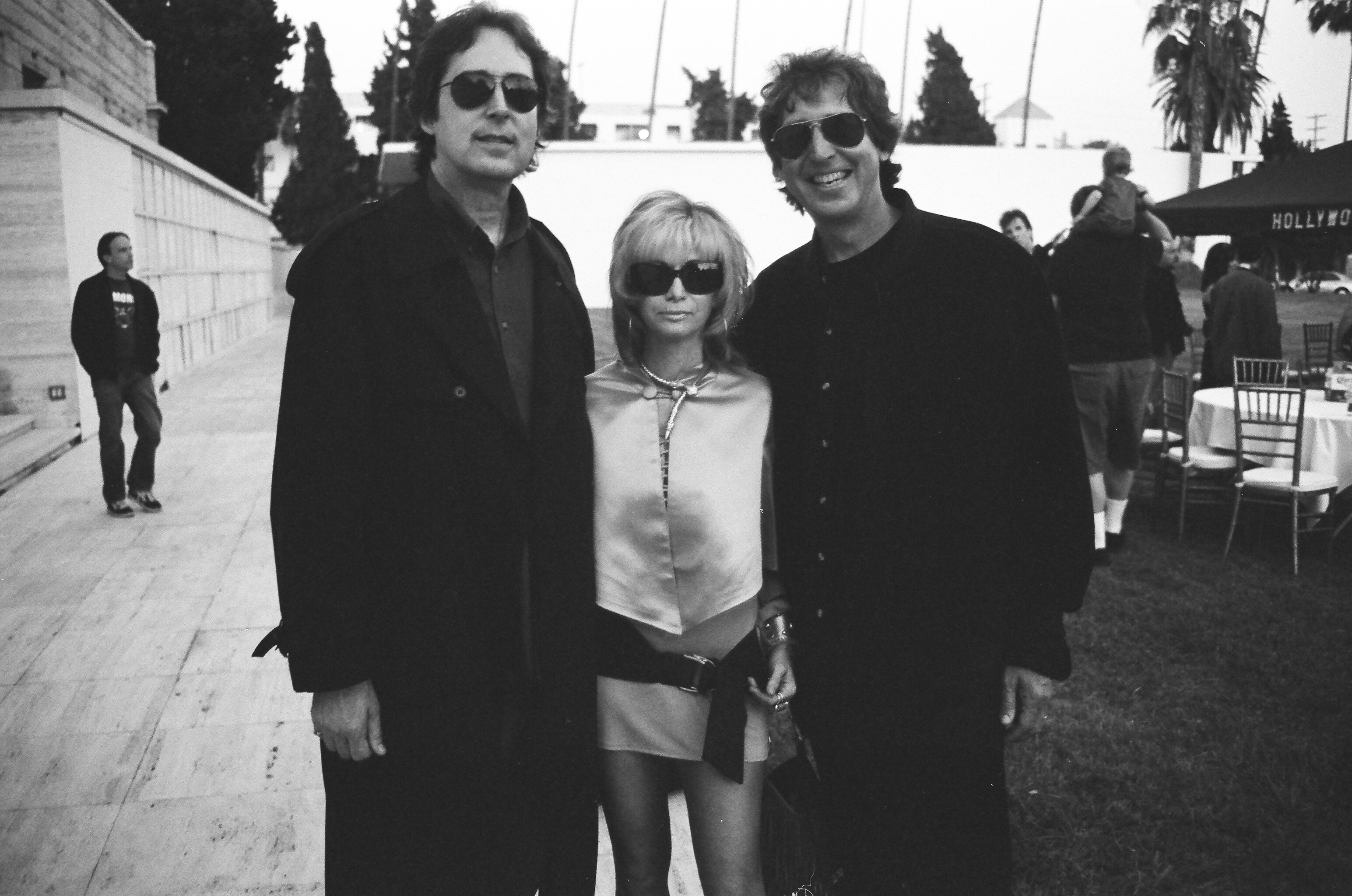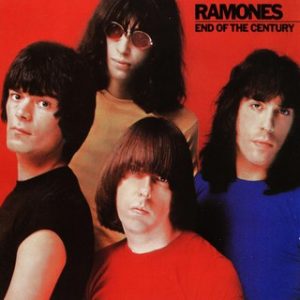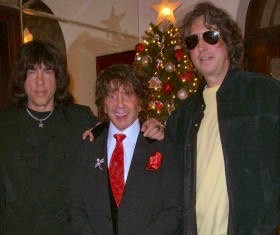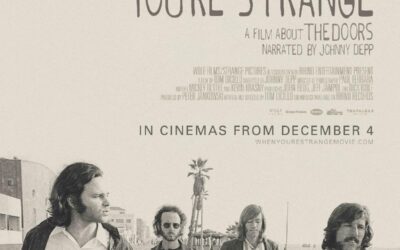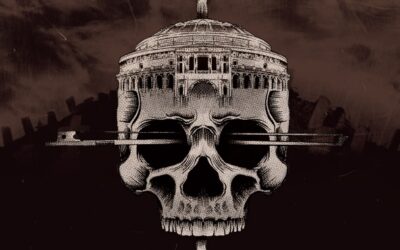End of the Century 40th Anniversary Expanded Edition Scheduled
BY HARVEY KUBERNIK © 2019
With the new September 2019 deluxe edition of the 1979 Ramones’ tour album, It’s Alive, and the planned last quarter 2019/early 2020 40th
anniversary of the original Phil Spector-produced End of the Century, with producer Rick Rubin now involved for an expanded reissue of the initial pressing, multi-instrumentalist David Kessel and his cavehollywood.com website asked me to re-visit End of the Century, cut at the landmark Gold Star Recording Studios in Hollywood.
I was in attendance at just about all End of the Century sessions, as a food runner, and on occasion, supplied hand claps and percussion, and was credited on a few tracks.
I eventually penned the liner notes for a 2002 Rhino Records repackage of the album. It was an assignment that came just after ownership changes at the label. The late great Gary Stewart graciously insisted that I do them knowing I covered the Ramones/Spector relationship for the London-based Melody Maker.
So, before we hear the upcoming “revised” Rhino/WMG label End of the Century in a handful of months, cavehollywood.com is displaying portions from my 2002 product text with additional and un-published 2002 interviews with Johnny, Dee Dee and Marky Ramone.
During August 2019, I saw the opening night world premiere of 33 1/3-House of Dreams, the musical stage show about Gold Star co-owner/engineer Stan Ross at the San Diego Repertory Lyceum Stage Theatre written by Jonathan Rosenberg and Brad Ross, son of Stan Ross.
Ross and his partner Dave Gold owned Gold Star which garnered more Recording Industry Association of America (RIAA) Songs of The Century and Grammy Hall of Fame winners than any other independent studio in America. Gold Star was built in 1950 and lasted until 1984 at 6252 Santa Monica Blvd until a fire destroyed the property in March 1984.
There were many show-stopping moments in 33 1/3 House of Dreams including a revealing scene between Phil Spector, the Ramones and the alarmed Gold Star staff.
But what brought the Ramones, Phil Spector and Gold Star together? The week before he began the Ramones album, Spector helmed a production of Jonathan and Andy Paley’s “Baby, Let’s Stick Together” done at literally the last formal “Wrecking Crew” session at the famed studio. Ray Pohlman, Hal Blaine, Tommy Tedesco, Jay Migliori, Jim Keltner, Julius Wechter, Steve Douglas, Barry Goldberg, Don Peake, and Dan and David Kessel were on the date. I provided some percussion on the recording with Rodney Bingenheimer and Phil Seymour. Darlene Love and Joey Ramone also came to the session.
During 1979 the week before the Ramones flew to Los Angeles for these Spector sessions, the band recorded five demos with engineer/producer/guitarist Ed Stasium, which were included on the Rhino/WMG distributed 2002 re-release.
“These were the first demos I did with the Ramones,” remembers Stasium. “We did them all in one day. Johnny ran it like the military, all prepared and ready to go. We cut them on a Thursday, and the next week we were in Hollywood rehearsing at Studio Instrument Rentals for four days before End Of The Century started with Phil.”
On May 1, 1979, the Ramones entered Gold Star Studios in East Hollywood, California, with producer Phil Spector. I was there, covering the action for Melody Maker.
The progenitors of punk rock had already created a legitimate legacy with albums such as Road To Ruin, Leave Home, and especially their self-titled LP, which stuck to the listeners’ synapses like a garage-staining fungus. But End Of The Century brought them together with one of the true architects of sonic studio moxie, Phil Spector, and was cut at a recording studio that had seen not only Spector’s finest work but also awe-inspiring endeavors by the likes of Herb Alpert & The Tijuana Brass, Buffalo Springfield, Brian Wilson and the Beach Boys, Iron Butterfly, Barney Kessel, BJ Baker, Chris Montez, Jack Nitzsche, Sonny & Cher, and Eddie Cochran, among others.
The Ramones made their way to Spector and the legendary Gold Star world via several denizens of the Los Angeles music scene. The band had played backing tracks on a cover of “Surfin’ Safari” for Rodney & The Brunettes, deejay Rodney Bingenheimer’s side project. Producing that session were local creative duo and Spector pals Dan and David Kessel.
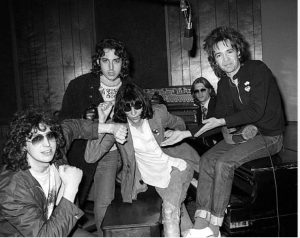
David Kessel, Dan Kessel, Joey Ramone, Rodney Bingenheimer, and Blake Xolton at Gold Star Studio- Photo by Brad Elterman
Throughout the 1970s, the Kessel’s guitar work, electric and acoustic, could be found on Spector productions and albums by Harry Nilsson, Cher, John Lennon, Darlene Love, Dion, the Paley Brothers, and Leonard Cohen.
In 1978, Dan and David Kessel produced and arranged the Ramones song, “Slug” (available on the CDs All the Stuff (And More), Vol. 2, and Rocket to Russia, as well as on Rhino’s 2005 box set Weird Tales of the Ramones.
“Dan and I got on the phone to Phil,” David Kessel recalls, “and played Phil some of what we had produced with the Ramones. His immediate reply was that we should pick up some pizzas and bring the Ramones over to his mansion in Beverly Hills. That was truly a happening night.” Bingenheimer and the Kessel brothers then brought Spector to see a Ramones show at the famed Whisky A Go Go. I met them at the venue. It seemed like a moment that was bookended for history.
In an interview with veteran music journalist Jaan Uhelszki, Joey Ramone explained that Spector wanted to record him solo. “I guess the way it originally came about is Phil wanted to do a solo record with me, but it was a little premature. This was only our fifth record,” he told Uhelszki. “It excited me because he loved my voice. He would say to me, ‘I’m going to make you the new Buddy Holly.’ As for the rest of the Ramones, they thought he was trying to steal me away.”
Recording with Spector, and tolerating the maestro’s demanding hours, resulted in the logical next step in the Ramones’ musical evolution. Following the group’s initial experimentation on Road To Ruin—which featured 12-string acoustic guitars in the mix, and what, for the Ramones, amounted to a genuine ballad with the Sonny Bono/Jack Nitzsche ’60s classic “Needles And Pins”—the progression to End Of The Century was the culmination of the band’s desire to make a great rock ’n’ roll record.
Larry Levine, Stan Ross’ cousin, was one of the house engineers at Gold Star and a crucial component in Spector’s “Wall of Sound” audio endeavors.
Larry engineered sessions for Eddie Cochran, the Beach Boys, Sonny and Cher, Herb Alpert & the Tijuana Brass, Dr. John, and with Spector in the late 70s albums by Leonard Cohen and the Ramones’ End Of The Century, with Boris Menart and assisted by Bruce Gold.
“As far as the room sound and the drum sound went, because the rooms were small, with low ceilings, the drum sound, unlike other studios with isolation, your drums sounded the way you wanted them to sound,” mentioned Larry to me in a 2002 interview. “They would change accordingly to whatever leakage was involved.
“As a matter of fact, Phil once said to me the bane of his recording existence was the drum sound. A lot of people attribute to echo to what Phil was doing. The echo enhanced the melding of the ‘Wall of Sound,’ but it didn’t create it. Within the room itself, all of this was happening and the echo was glue that kept it together,” suggested Larry.
“I used to have a theory [that] part of the reason we took so long in actually recording the songs was that Phil needed to tire out the musicians—[until] they weren’t playing as individuals, but would meld into the sound that Phil had in his head.”
The opening blast of “Do You Remember Rock ’N’ Roll Radio?” is the perfect balance between Spector’s Wall of Sound and the Ramones’ Wall of Buzz. This is the one track on the album where the fusion of the Ramones’ and Spector’s sensibilities exceed the burden of heightened expectations. The dark romanticism of the next song, “I’m Affected,” is driven home with loads of echo on Joey’s vocal and a menacing backing track from Spector and the band that underscores the track’s proclamations of love with a threat of violence.
On the sweeter side, echoes of The Beach Boys’ “In My Room” float through “Danny Says,” from its delicate, chiming guitars to the childlike intonations of Joey’s singing. The lyrics, dealing with “a typical day in the life” of the Ramones on tour and including numerous insider references, make this one a particular fan favorite.
“Chinese Rocks,” or “Chinese Rock,” as it has been documented over the decades, is a track co-written by Dee Dee and Richard Hell, which was originally given to the Heartbreakers to record.
“Dee Dee came to rehearsal with the song ‘Chinese Rocks,’” reminisced Johnny Ramone, “and we said, ‘Dee Dee, we’ve just written two songs similar to it…one was ‘Commando, and I don’t remember what the other one was. But there were two songs that were very similar to it, and it was about dope, and I said, ‘We don’t sing about dope…we’ll just hold it’. And I think he got insulted by that, and went ahead and gave it to the Heartbreakers. Then I heard the Heartbreakers version, and said, ‘Hey, that’s a really good song.’ So that’s when I realized that it was a good song, and we incorporated it into our set.”
The record’s fifth selection, “The Return of Jackie and Judy,” is a musical sequel to “Judy Is a Punk” from the Ramones’ first album. Rodney Bingenheimer, Phast Phreddie, Maria Montoya, Jeff Morrison and myself all contributed handclaps like which we also did on “Do You Remember Rock ‘N’ Roll Radio?”
Revisiting the past is always a dicey proposition, and the song’s a pale carbon copy of the prototype. Drummer Marky Ramone agrees: “I
don’t like, ya know, stories that continue into another relation song that develops. I felt it was kind of corny.”
The album’s midway point, and one of two tracks on the record co-written by Johnny and Dee Dee, is “Let’s Go.” Perhaps an even better Ramones homage to the girl groups of the ’60s is “I Can’t Make It On Time.”
Another incredibly infectious track on the record is “This Ain’t Havana,” co-written by Dee Dee and Johnny. It’s the album’s best example of the band’s celebrated sense of humor.
A re-recorded “Rock ’N’ Roll High School,” slotted in as the album’s tenth track, features fleshed-out production that loses some of the raw kick of the bare-bones original.
The last two cuts from the album, “All The Way” and “High Risk Insurance” round out End Of The Century in solid Ramones style. Surprisingly, Spector doesn’t tamper much with the basic guitar-bass-drums attack that the band was justifiably famous for, and they deliver a pair of straight-ahead rockers.
Spector was against recording anything he had previously done, but at the urging of the band and Sire Records label head Seymour Stein, Phil agreed to produce a cover of Barry/Greenwich/Spector’s “Baby, I Love You” for End Of The Century. The Ramones’ rendition unfortunately comes perilously close to disco to make for entirely comfortable listening for most of their fans; and the slick production and strings overwhelm the song’s natural charm. Consequently, it’s easily the most divisive and disliked song on the album.
Regarding “Baby, I Love You,” Johnny Ramone offers his point of view: “Yeah, I wanted to do a Phil Spector song. . . . I realized that it was a mistake, and to me it was the worst thing we’ve ever done in our career.
“But on ballads like ‘Danny Says’,” Johnny continues, more upbeat, “the production work is tremendous. On ‘Do You Remember Rock ’N’ Roll Radio?’ the production works. On some of the things it works, some of the things it doesn’t work. Because of the echo and reverb, I can’t separate; I like to distinguish the guitar from the bass guitar from the drums. I can’t distinguish the separation, because it’s muddy. That’s the sound.
“We had the album cover where we have no jackets on…I wasn’t happy. We took the picture without the leather jackets, and we should have never had done that, and then we took a picture with the leather jackets…
“The photographer…and Joey and Dee Dee said, ‘Maybe we’re not getting played because we have leather jackets on…let’s go with that picture.’ I was against that, and Mark was against that too, but they said Mark’s vote didn’t count. So it was two against one; it was a power struggle going on where Dee Dee and Joey were pals at one point, and that’s what was just happening; and Mark’s vote didn’t count, and we put the leather jacket photo on the inside sleeve. I thought it was selling out – this was our image, and we should stick with our image, and either sink or swim with it. I thought it was compromising and selling out. I didn’t want anyone coming up to me and saying, ‘You guys are selling out…’ And it had “Baby, I Love You” on it, too…so this was not a great period.
“Looking back, I’m glad I worked with Phil–I worked with a legend of rock ’n’ roll. The last things I know of that he’s done are the Ramones and the Beatles. . . . I’m proud to be part of his discography. . . . At the time I did it, it was very difficult, it was very stressful. But I’m still happy I did it.
“On stage we did ‘Rock & Roll Radio’ always, from the time the album came out through the rest of our career. ‘Rock & Roll High School.’ ‘I’m Affected’ was in the repertoire for a while. ‘Chinese Rocks’ always stayed in the repertoire. ‘Danny Says’ we never did. It was a production song, it was never gonna work.
“The point it shows is when you’re making a record. It shows you can play, and you do what you’re supposed to do, and you do your part. But when you’re not communicating, that’s when it shows; you’re not writing together. Once Dee Dee and me started getting friendly again – I think on Subterranean Jungle, and more so on Too Tough To Die – we started working together.”
“Playing bass with the Ramones,” observes Dee Dee Ramone, “I think I had a real good sense of time. That’s one thing. I could play bass like a drummer and I don’t know how other people do it, and they get better, or learn guitar tapping, whatever.
“There’s something about playing live that just makes you better. John and I had been playing for years and we played every night. Very few nights we didn’t play. We had a standard joke. We never rehearsed ‘cause we were always playing. To get the speed though, we had to warm up and we used to warm up in the dressing room with a trap kit, or fake drums, a Fender Champ amp. And that’s it. We would get the speed with the right hand going, until finally it grew to playing. Only playing down strokes and then playing back. Speed, aggression, but if you are a singer/guitar player, you have to play up and down strokes or pause a little on the guitar. And John and I weren’t like vocal musicians. That’s what happened to us. We’re like a machine.”
Dee Dee is equally intrigued by the EOTC recording, especially in hindsight: “Now I realize more and more,” with time Joey’s voice had a real deep, deep part of the Ramones’ sound. And really that started with End Of The Century. I think Phil Spector and Joey were a great combination. Phil brought out the romanticism in Joey. He was like a romantic guy, and some of the songs and productions on End Of The Century pushed that. . . . And ‘Baby, I Love You’ on End Of The Century—I never thought there would be a string section on a Ramones record, but I like it.
“The thing with Marky as a drummer was that he was very particular about the drum sounds and all of that. But I think Joey was into a Keith Moon type drummer who would splash around the tom toms and all that thing. But you know what, we didn’t bother Marky in the studio. He is a very self-willed person, and Johnny Ramone would show him a lot of parts. I wouldn’t worry about what everyone was doing, I would just lead it.
“The Ramones got a lot of new attention due to the End Of The Century album: Scotland, Holland, and Spain, we got a lot of TV shows, it got to be scary. We’d get to The Apollo Theater in Glasgow, Scotland, and we’d been playing it for years, then all of a sudden all these very young girls were at the gig. I don’t think they’d see the Ramones, but they wanted to hear ‘Baby, I Love You.’ There was a video and it charted in Europe.
“I don’t think I knew how great the Ramones were in a way then. Also with End Of The Century, it was the first album we didn’t record in New York.
“The songs translated well on stage. ‘I’m Affected.’ We did the video on top of Joey’s roof of his apartment. Well I think the End Of The Century is Joey’s Ramones album, that one or Pleasant Dreams. That’s his album. There’s nothing wrong with that.
“Of all the albums, the End Of The Century sticks out and shows a side to the Ramones that didn’t get developed and couldn’t have developed because of the obvious: we were a tight rhythmic band, although we’re not musical virtuosos, but what we did we did good. And you look at that cover and see that pop side to us that loved Rubber Soul by the Beatles, or the regimented pop groups. I think it’s nice to see the whole collection of albums and the covers, and that the whole thing ever existed.”
“On this album Mark was just so much more versatile and able to do so much more stuff,” remarked Johnny. “It was actually easier. We didn’t have Tommy’s guidance anymore – that was more of a problem, because Tommy would intercede a lot.”
Drummer Marky Ramone is very proud of his End of the Century experience.
“I still listen to the record and try to understand what Phil did, which can baffle a lot of people. He’s like a conductor,” underscored Marky. “I was amazed how a certain sax can jump in, then a certain guitar tone would pop up . . . the way the roto-toms bounced off the walls to create that low-end hum after the end of the hit, which bounced right back onto the recording.
“The combination of the walls of sounds were like two 50 foot tidal waves hitting each other and how Phil’s influence made us sound like a Sixties band with the Marshall’s, and all the later, heavier equipment, and of course, the Ramones’ sound.
“It was all fun and we did our jobs. For John and Dee Dee it was a nightmare. They were used to working fast, and Phil worked at his own pace, which really frustrated John and Dee Dee because of how things were working. Personally, Phil was the producer and I went along with what he wanted ‘cause I knew of his experience.
“Gold Star had a great room. I was facing Phil and engineer Larry Levine while doing the LP. Phil and I would put a towel on the snare drum on certain songs, an old trick, especially on ‘I Can’t Make It On Time.’ I could see Phil grooving along with my tempo and I knew when he did that he was liking it! Me, Dee Dee and Johnny would play together then Ed Stasium would overdub some leads. We knew our vibe real well.
“I like ‘Danny Says’ because it was your typical ‘Phil the great build up’- the master at work. And of course, ‘Do You Remember Rock ‘N’ Roll Radio?’ All the different and wonderful instruments that wove in and out of the song. And of course, ‘I’m Affected.’
“But to me it all worked. The songs sounded like one and that the way I feel all songs should sound. Not one thing should stand out louder than the other. “‘Chinese Rock,’ I liked the Heartbreakers’ version better because I liked the speed they played it. I thought ‘Rock ‘N’ Roll High School’ was definitely great. I also really like ‘Danny Says,’ which Joey wrote because I enjoy touring.”
I had a lengthy chat with Joey Ramone one night by the Gold Star Coca-Cola machine (which only stocked Tab) in the hallway. Joey, who shared the same May 19th birthday as Pete Townshend, was so stunned when I told him the Who mixed “I Can See For Miles” and produced “Call Me Lighting” at Gold Star, that he took off his glasses and shook his head in amazement. Joey and I had both seen the Who in 1967 on their first U.S. tour but on different coasts. Joey almost fainted when I told him that I had deejay Murray the K as a guest on my 1978 television show 50/50.
Joey and Phil developed a very close friendship in spring 1979. One evening Phil took Joey to see director Ridley Scott’s epic Alien on Hollywood Blvd.
I also remember Joey recording his vocals with a unique setup in the studio.
Boris Menart, an engineer on the EOTC sessions, notes, “[One] thing Phil did was when they recorded Joey’s vocals, because he was so used to standing onstage holding his microphone, he would sing with one microphone on the stand and another microphone right above him that would record as well. He was so used to standing holding a mike in front of his face when he was singing, he was sorta comfortable like when he was onstage. In the mix we would bring his vocal back so he wasn’t right on top of it.”
Joining this tumultuous brotherhood on some of End Of The Century’s tracks were several guests.
“The supplemental musicians on End Of The Century,” confirms Dee Dee, “the guests had to save it. They made an impression on the way things were recorded, and we’re lucky we had ’em. I think I played my bass parts, and Mark played most of the drums, but everybody tried to help make the record. Thank God Ed Stasium was there, Jim Keltner, and the Kessels.”
Longtime Ramones associate Ed Stasium served as musical director on End Of The Century and deserves an office in the United Nations building for his efforts. “Ed was a very skillful guitar player and producer,” Dee Dee mentions. “Phil didn’t have to say too much to us. Phil could ask Ed, and he would translate to avoid conflicts. Musicians don’t take well to criticism. I was having a good time, no matter what. The more people who were there, the safer I felt.”
“Ed Stasium is into hard rock, he’s easy to work with, a pleasant guy,” underlines Johnny Ramone. “I never remember having a problem with him on anything, ever. He was a nice guy, always a joy to work with.
“It was stressful. I wanted out of the band. I was getting pains in my chest….usually I can deal with the stress, but…”
“Johnny Ramone was the new Link Wray,” emphasized Dan Kessel. “We were proud to be Ray-Men. Johnny was a phenomenal bandleader. Dee Dee and Marky were both extraordinary too. And Joey was inspirational.
“When we were recording, David and I would thrash on our acoustic guitars all night long until our hands were bloody and raw. We’d mainly just keep playing rhythm, staying out of Johnny’s way, following Marky and Dee Dee. Other times we’d play more nuance things, rhythmically or harmonically, as requested, when Phil was building on the arrangement.”
If you were to ask Barry Goldberg, songwriter-producer (as well as the keyboardist with the Electric Flag and Bob Dylan sessions and live gigs), he had one of the most incredible times of his life playing organ, keyboards, and what he calls “a celesta kind of Buddy Holly thing” on the record.
“Phil called me up in 1979,” Barry opens, “and said, ‘I’ve got something really important for some sessions.’ But he didn’t tell me what it was. I didn’t know until I walked into Gold Star.
“I found out when I walked in and saw all the Ramones, right. I loved the Ramones. They were rock ’n’ roll. And I started talking to them, and they found out I played keyboard on the Mitch Ryder stuff, and they loved ‘Devil With A Blue Dress On.’ They accepted me.”
Drummer Jim Keltner played on “Baby, I Love You.” Jim had known Phil for years and worked with him many times, including sessions for Leonard Cohen and John Lennon.
“The Ramones played great together. Their drummer Marky was remarkable,” Keltner volunteers. “They had lots of power and energy. It made sense that Phil would produce a record for them. I mean, he’s always been punk.”
“You either loved it or hated it,” Joey told Uhelszki of End Of The Century.
“The thing was, Phil had never worked with a band before, especially a band like us; his artists were more of his own conception,” Joey continued. “The Ramones were a band, and we had our own focus, and Phil had his own focus, and in some ways it was a clash. The thing is, Phil likes to dominate and manipulate, so it was a little strange. But on the other hand, I felt like I was performing for the master, you know what I mean? I learned stuff from Phil; it was the kind of experience few people have.
“It’s a historical record,” concluded Joey to Jaan, “and one of the last ones Phil actually completed. He’s a very passionate, high-drama person. I still admire him. Of course, I can say this now looking back on the situation—but during his episodes nobody was enjoying, or having any of it . . . . All work ceased and we were all pissed off with his drinking, his antics, high drama, and the insanity.”
Contrary to popular belief, the End Of The Century sessions with Spector didn’t fracture some already-established brotherhood bond between the Ramones, nor was it as dramatic as depicted in the folklore around the LP’s initial release. Although, according to what Joey told Uhelszki, it was true that Phil pulled a gun on Dee Dee—after Dee Dee had taken a swing at him. Spector had been packing heat after he was robbed just before the sessions began.
“The Ramones were a pain in the ass, too, come on,” Dee Dee admits. Still, he adds, “Playing with the Ramones was wonderful—it was probably like bungee-jumping.”
When the record was first released, it received great acclaim from much of the mainstream press (notably Rolling Stone and Time, which deemed it one of the best rock albums of the year) and would go on to become the Ramones’ biggest chart success (#44 on Billboard).
Though punk fans remains divided on the album’s merits, there is a growing cult of admirers who embrace it.
According to Martin Banner of punk fanzine Flipside, “The best thing about End Of The Century for me is that they stayed true to their heroes. The Ramones loved the bass-guitar-drum churn of the early Beatles, the Wall of Sound of the Spector girl groups, The Beach Boys’ perfect, three-minute pop gems, and the roar of the ’60s garage bands. They fused them all into one amazing, underrated record. It’s a rock ’n’ roll car-crash of Spector-sized ambition and Ramones’ energy that sounds better and better with each passing year.”
In the end, End Of The Century (the title was Spector’s) was the by-product of environmental historic tensions; faith-based initiatives; stress; instrument collision; contracts; passion, fury, and confusion; freedom of will; paychecks; a continuing musical education (for everyone involved and hopefully everyone listening); the Professional Musicians Local 47 union; alcohol and soft drinks; herring, tongue, and hearty, delicious corned-beef sandwiches from Canter’s deli; and particularly the harsh melodic tunes on oxide-soul contracts played by a nervy rock ’n’ roll band, aided by a few deck hands, produced by a maverick music man. And it’s an album that makes a definite impression.
“Unlike most every single other remnant of the old school’s olden guard dismissive of – no, make that threatened by the new sonic Spirits of ’76, Phil Spector recognized in those very seismic shifters a rebellion ‘n’ roll that had far too long been gone from the Top 40,” insists Gary …make that Gabba Pig Gold. “It should come then as no shock whatsoever that the band he chose to lift out of the new waves onto his Wall of Sensation was the one which, with its lead singer’s inflections alone, mixed Peter Noone and Ronnie Ronette with the six-string buzzsaw of sand, surf and far-from-California sun.
“Most unfortunately though, it has since been cruelly misreported – often by some of the very participants themselves – that the unholy union of Phil to Ramones produced little but the last bonafide artistic gasp from either; lurid tall tales of Mannlichers and Manischewitz clouding what in truth was one of the most courageous, not to mention loudest months in Gold Star history. Suffice to say the album which resulted, though polarizing to many within the Ramones’ blinkered fanbase, stands today as perhaps the final Big Bang in all of American rock, not to mention a sorry signpost towards what the dreaded digitized Eighties should have sounded like had End Of The Century spent at least as much time on chart-tops as, say, The Wall or The River.
“Instead, what we can, and should hear to this day within its groove is thirty-four minutes of pure, powerful pop with a sly wink and nod to the past via a brave, bold barreling towards the high-risk future all involved were facing, if not facing down. No, EOTC didn’t make any Ramone a fortune or a household name, leading man Phil soon after vanished forever back behind his Wall of Shadow and, alas, the Century they all sang of turned out to be quite some denouement to them, and to us. But, personally speaking, I still proudly file my vintage-1980 pressing right there alongside Odessa and Self Portrait: totems to the very ethic of possibly-flawed masterworks the world – not to mention your record collection – is so much the better to have in pride of place.”
In my 2002 interview with Johnny Ramone, we talked about touring and the Ramones’ legacy.
Did he always know that the road and constant touring was going to be essential to their economic success?
“Of course! We were recycling everything. The drumsticks would come off the kits, everything, and sell ‘em out there for a profit. Sticks get used, we get the sticks for $2 a pair, and then we’d sell the used drumsticks for $5 apiece – used drumsticks. Everything was to turn a profit, yet to still keep it at a reasonable price, so that if the kid got an item, he’d go. ‘Hey, I got a good deal; here’s a good used drum stick for $5,’ and it’s still a good deal, ya know…
“I learned by just watching Cream come out on stage, and I watched what they did just by presenting themselves. I saw how important it was – perception – how the group was perceived from the moment the band walked on stage – how important to walk on the stage properly. You know, the stage is dark and there’s no lights – ‘This is the most exciting moment…now, how long is it gonna take for the band to blow it, ya know, with boredom’? I learned so much from doing that.
“Walk on, don’t start fumbling around; if something breaks, don’t make it obvious to the audience – they don’t know. I’d tell Dee Dee, ‘If your microphone doesn’t work, just throw it down, scream out the count. Don’t have any vulnerability, where you go on, ‘Testing, testing….’ Don’t show any vulnerable moment. Perception is everything…
“Well, I bought the guitar in January of ‘74, and we started playing CBGB’s in August of ‘74. So that’s when I started playing guitar. I started down-strumming to keep time, ya know. I also liked the way Jimmy Page played on ‘Communication Breakdown’ (sings ‘da-da-da-da-da/da-dum-dum’) I liked the way it drives…“But what made me get into a band were bands like The New York Dolls or Slade.”
I also asked about the current re-appraisal of the Ramones and their catalog popularity and merchandise sales.
“Well, I told my wife the year before I retired, ‘Well, maybe no one will wanna talk to me, and we’ll just be forgotten, and that’s how it’s gonna be, and I’m prepared for that…’ That’s what I told her, all the time, just in case that was gonna happen. I can’t believe it – I hear about the Ramones every day. I see stuff about the Ramones, I hear people talking about the Ramones…I just thought I’d be forgotten,” admitted Johnny.
“I got in my car two days ago, and Paul Stanley pulls along side of me – I’ve never spoken to the guy before – and says, ‘I’ve seen you around before, but I’ve never met you, but I just wanted to say hello…’
“This is nice, Paul Stanley saying hello. Don Henley comes up to me one day, outside of The Ivy (restaurant) and says – and I have no idea who Don Henley is, but I’m thinking he must me somebody important – ‘I hear you’re retiring ya’ know, and you shouldn’t retire…’
“I tell him, ‘It’s been a great 22 years of my life, but it’s time to move on…great, thanks for saying hi to me…’ I’m thinking, ‘Who the hell is he?. I get home and say, ‘This guy Don Henley said hello to me…’ and (my wife) goes, ‘Don Henley! He’s in The Eagles!’
“But as far as the compliments from the people like Eddie Vedder, it’s great, it’s tremendous. I didn’t think I was appreciated throughout the 1980’s. It wasn’t until the 1990’s – around ‘93/’94 that people started coming up to me and saying these things, and asking me to go on tour with them. And I started thinking, ‘Hey, this is nice…’
“See, we stayed in our own world so much that we didn’t think anyone cared; we thought were totally unappreciated.
“What’s good is that I have these friends like say Lisa Marie Presley, she didn’t listen to the Ramones. She’s my friend, she heard they were good; and now we’re in The Rock and Roll Hall of Fame. ‘Wow! I guess you guys were better than I thought.’ So that’s good, that a friend like her will say ‘You’re good.’”
I told Johnny that the Ramones are now looked upon as a legacy group!
“Yeah, yeah, yeah…I never thought this! (laughter). I thought we’d do one album, and I’d go back to construction work, ya know.”
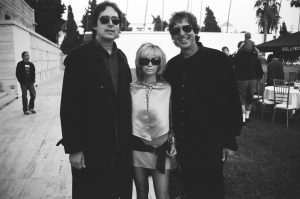
Dan Kessel, Linda Ramone, David Kessel at a Holly Forever Cemetery Johnny Ramone tribute- Photo by Harold Sherrick
While we wait for the 2019 expanded configuration of End of the Century and hear Rick Rubin’s participation and results, I conducted a 2009 interview with Rick for my book Canyon of Dreams The Magic and the Music of Laurel Canyon about his bio-regional link to the magical music created in the region and at the Gold Star facility.
“It’s not lost on me that I was in rooms where Brian Wilson cut. Some of my favorite music that played a part in bringing me here… Then I began to realize the people and musicians who went to Fairfax High School: Herb Alpert, Phil Spector, Mo Ostin of Warner Bros, Anthony and Flea of the Red Hot Chili Peppers.
“For example, on the last Chili Pepper’s album we used all of these tube microphones with the engineer Mark Linett, who did the recent Brian Wilson Smile and he did the basic tracks. And he used all of that ‘60s, vintage Beach Boys’ type gear, equipment that had been in Gold Star, Western. So there are elements that travel from Sunset and Santa Monica Blvd. into Laurel Canyon.
“Buffalo Springfield, Byrds and Hollies are things I listen to all of the time anyway. I pretty much exclusively listen to music from the ‘60s.”
In 2003, Rubin produced a cover of Iron Butterfly’s “In-A-Gadda-Da-Vida” that was first birthed at Gold Star in 1968 where it was mixed with engineers Jim Hilton and “Doc” Siegel, who was a resident Gold Star engineer 1964-1970 and did the Buffalo Springfield debut LP.
“That Iron Butterfly song is one of the great heavy songs and it just seemed appropriate for Slayer,” reinforced Rick. “It’s interesting, because Slayer is such an extreme band that people who are not into that kind of music, because it’s different now, because there’s a lot of varied fast, hard music.
“But at the time they came along, like the first time you heard the Ramones, you don’t really know what to make of it. That was the case with Slayer. People didn’t even know if it was music. So that was a song that fit Slayer and told a story that this is the lineage that they come from.”
“I love seeing people of all ages wearing Ramones’ t-Shirts,” offers music industry veteran David Kessel, “from little kids to oldsters. They’re letting their punk flag fly. The Ramones cross all generations because their music and lyrics reflect a parody of reality.
“I’m amazed and delighted that after all these years since the Ramones showed up on the scene, and became the scene, they are more popular globally in 2019 than ever. What they created is entrenched in our modern musical DNA.”
(Harvey Kubernik is an author of 16 books. Kubernik’s The Doors Summer’s Gone was published by Other World Cottage Industries in February 2018 and just nominated for the 2019 Association for Recorded Sound Collections Awards for Excellence in Historical Recorded Sound Research.

